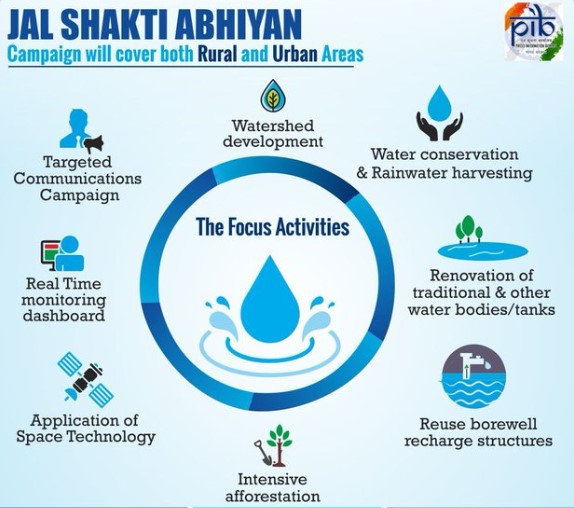JAL SHAKTI ABHIYAN
2021 JAN 13
Mains >
Geography > Resource geography > water management

WHY IN NEWS:
- More than seventy- five lakh traditional and other water bodies and tanks were renovated and around a crore water conservation & rainwater harvesting structures were created under Jal Shakti Abhiyan in 2019-20.
NEED OF THE SCHEME:
- India has 18% of the world’s population which has access to only 4% of the usable water sources
- Poor resources management and lack of government attention has contributed to water scarcity in India
- Furthermore, disproportionate use of water for agricultural use, excessive ground water pumping and deficient monsoon in the last couple of years make the demand-supply balance more critical.
- As per NITI Aayog report 2019:
- Around 45% of the population in India is facing high to severe water stress
- 21 Indian cities will run out of their main source of water i.e. groundwater by 2020
- Nearly 40 % of the population will have absolutely no access to drinking water by 2030
- 6% of India’s GDP will be lost by 2050 due to the water crisis.
SALIENT FEATURES:
|
Ministry of Jal Shakti
The Ministry of Jal Shakti was established in May 2019. Two ministries ,the Ministry of Water Resources, River Development & Ganga Rejuvenation, as well as the Ministry of Drinking Water and Sanitation, were merged together to form the Ministry of Jal Shakti.
|
- Launched by:
- The Jal Shakti Abhiyan was launched by the Ministry of Jal Shakti in 2019.
- Collaborative effort:
- It is a campaign for water conservation and water security in India, through a collaborative effort of various ministries of central and state governments.
- Officers, groundwater experts and scientists from central government will work together with state and district officials in India’s most water-stressed districts
- Coverage of Jal Shakti Abhiyan:
- To improve water availability including ground water conditions in the water stressed blocks of 256 districts in India.
- It is a time-bound, mission-mode campaign.
- The JSA will run in two Phases:
- Phase 1 from 1st July to 15th September 2019 for all States and Union Territories; and
- Phase 2 from 1st October to 30th November 2019 for States and UTs receiving the retreating monsoon
- The campaign will run through citizen participation:
- The JSA aims at making water conservation a Jan Andolan through asset creation and extensive communication.
- Ensure participation of students, swachhagrahis, Self Help Groups, Panchayati Raj Institution members, ex-servicemen and pensioners, among various others.
- Creation of infrastructure:
- Creation of local infrastructure for source sustainability using rainwater harvesting, groundwater recharge and management of household wastewater for reuse.
- The important water conservation interventions are:
- Water conservation and rainwater harvesting
- Renovation of traditional and other water bodies/tanks
- Reuse of water and recharging of structures
- Watershed development
- Intensive afforestation
- Development of water conservation plans:
- Block and District Water Conservation Plans will be developed
- Irrigation efficiency:
- Promotion of efficient water use for irrigation and a better choice of crops through Krishi Vigyan Kendras.
- Plantation
- Plantation plays a significant role in absorption of storm and rainwater for maintenance of ground water table, prevention of soil erosion and run-off and encourage growth of natural habitat for flora and fauna.
- ULBs will undertake plantation near water bodies, public spaces, parks and on roadside to improve green cover and water cycle.
CHALLENGES:
- Issue of coordination:
- Involvement of multiple departments with less or no coordination
- Lack of proper engineering supervision of these structures
- Limited funding:
- JSA is only aimed to make water conservation a peoples’ movement through ongoing schemes like the MGNREGA and other government programmes.
- The campaign was not intended to be a funding programme and did not create any new intervention on its own.
- Lack of comprehensive plan:
- Projects under JSA primarily involved building tanks and ponds to capture rainwater and building recharge wells to recharge groundwater, it is unclear whether they were based on reference to watershed management or groundwater prospect maps.
- Unclear targets:
- The government has given broader plans of JSA but there is a critical need to spell out the specific outcomes and targets in a tangible and achievable manner.
- In the absence of targets, the focus on objectives can be limited as one cannot ascertain the extent of work to be done, priority areas to be covered, and how to actually measure performance.
WAY FORWARD
- Launch a waste water policy
- There is a need for wastewater policy both for urban and rural areas that promotes water use efficiency, recycling and reuse, so that schemes like JSA can have more tangible goals.
- Legislative support:
- JSA cannot claim much success until excessive extraction of groundwater is prevented.
- Passage of two Bills - Model Bill for the Conservation, Protection, Regulation and Management of Groundwater, 2016 and the National Water Framework Bill, 2016 – to control exploitation of groundwater and managing river water
- Set up a monitoring mechanism:
- JSA should develop a monitoring mechanism along with the district authorities to ensure strict compliance of treatment and disposal of sewage and effluents before being discharged into water bodies.
- Ensure zero deforestation:
- Preventing the ongoing deforestation is a more suitable policy measure than planting trees with limited scientific and environmental understanding.
- Artificial forests cannot substitute natural ones. Artificial plantation leads to loss in biodiversity and native forests.
PRACTICE QUESTION:
Q. What are the salient features of the Jal Shakti Abhiyan launched by the Government of India for water conservation and water security? (UPSC 2020
